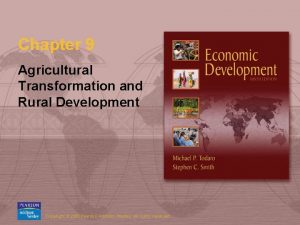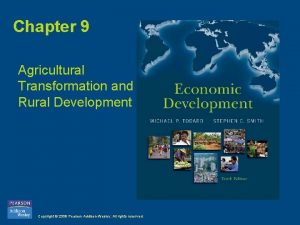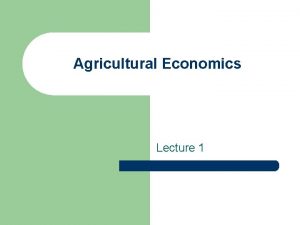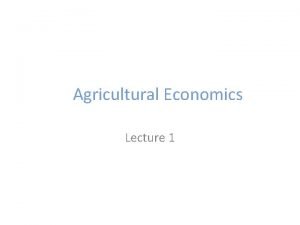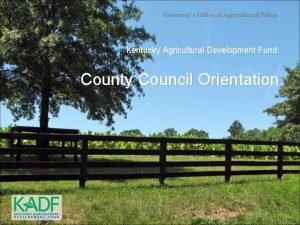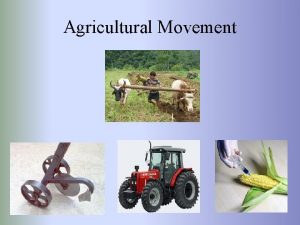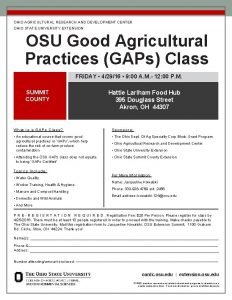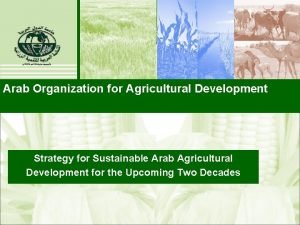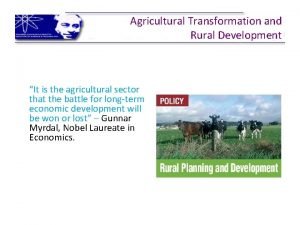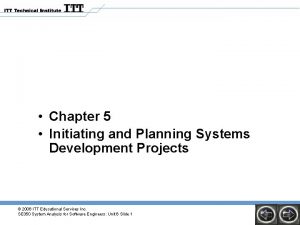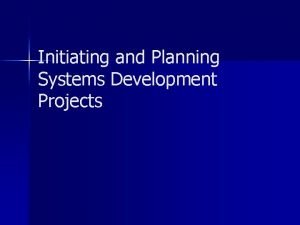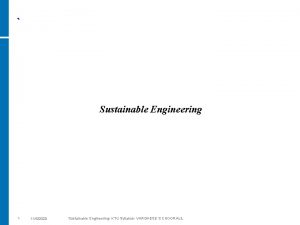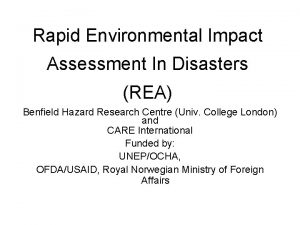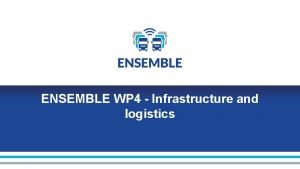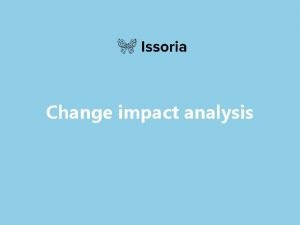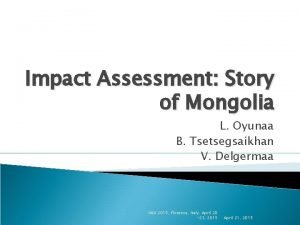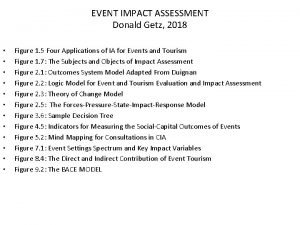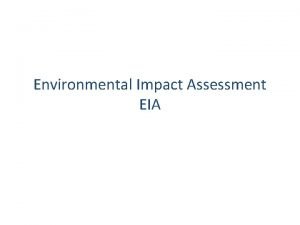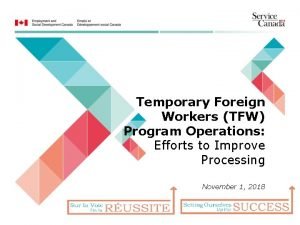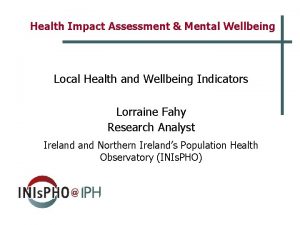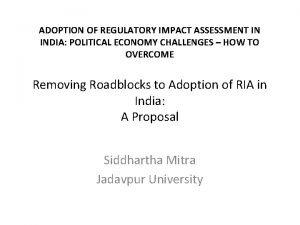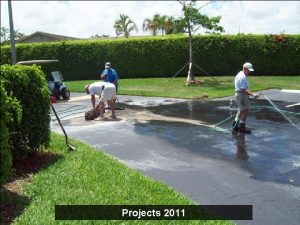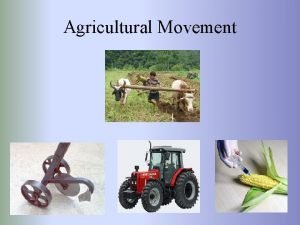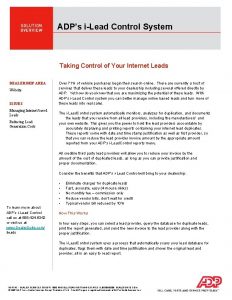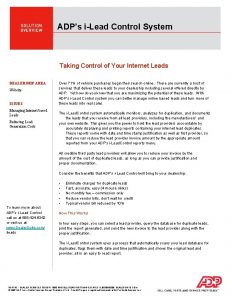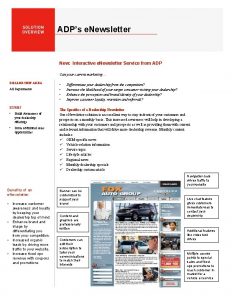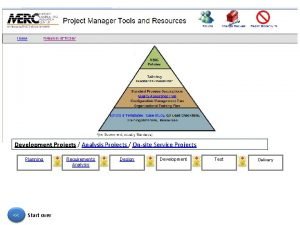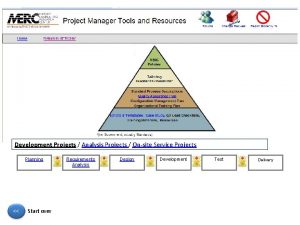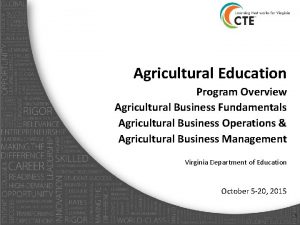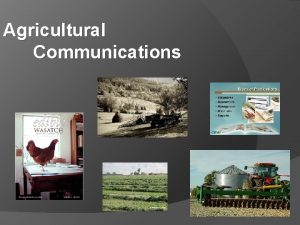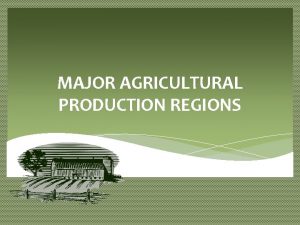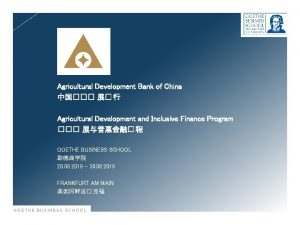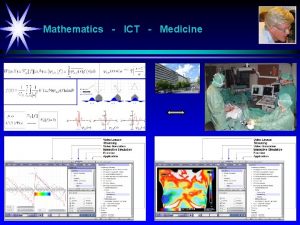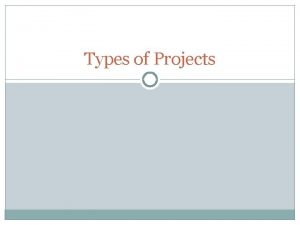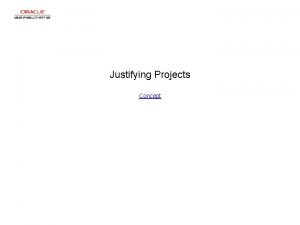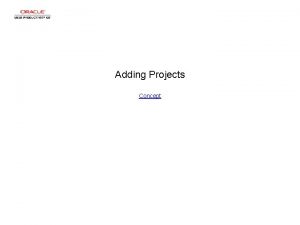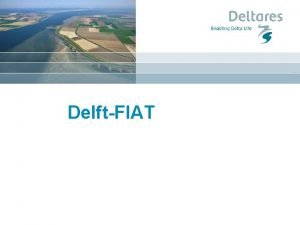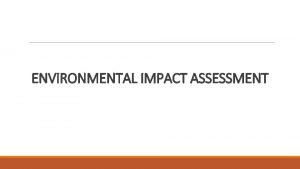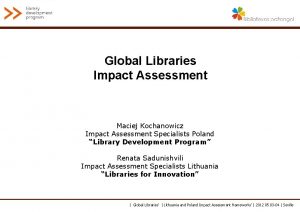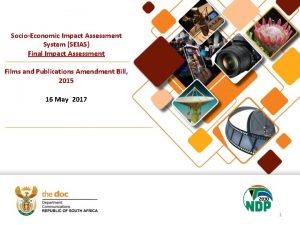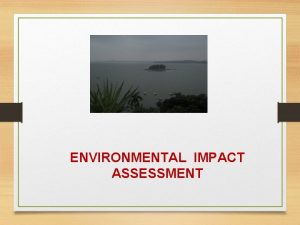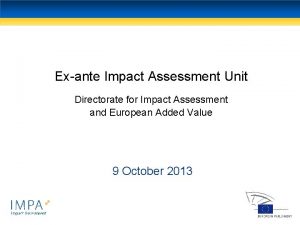Impact Assessment of the Agricultural Development Projects ADPs
























- Slides: 24

Impact Assessment of the Agricultural Development Projects (ADPs) on Fish Farming in Nigeria Dr. Harrison. N. Enabulele Department of Agribusiness and Consumer Science, College of Food Systems, United Arab Emirates University.

Outline of Presentation • Introduction and Problem Statement • Project Impact Assessment: Concepts and • • • Alternative Designs Research Objectives and Methodology Results and Discussion Summary and Conclusion

Introduction • Problems of Agricultural Enterprise Development in Nigeria - Categorised as problems inherent in the practice of agriculture itself (production-related problems operating within the sector) and - Problems operating outside the sector (country specific and the general society)

Problems of Agricultural Development in Nigeria Some Examples of both categorises of Problems include: - Natural e. g. unpredictable problems arising from weather and climatic factors - Technical e. g. lack of high quality and adequate farm inputs and technology - Financial regarded as the most crucial for agricultural development - Socio-economic e. g. characteristic features of the farms and farmers - Organisational associated with governmental/farmers organisations - Institutional and Politico-administrative e. g. the poor performances of governmental institutes vested with farm input-output distributions

The Origin and Objectives of the Agricultural Development Projects in Nigeria - ADPs idea was sought to promote agricultural productivity based improved technologies, enhanced extension delivery systems and supply of modern farm inputs and development of rural infrastructures Implemented in phases: 1975 -1982 Enclave and Statewide ADPs In 1984 First Multi-State ADPs in 7 States (Anambra, Bendel, Benue, Cross River, Imo, Plateau and Ogun), between 1985 -1989 MSADPs-II (Gongola, Kwara and Niger), MSADPs. III (Oyo, Ondo, Lagos, Rivers) Now 36 functional states ADPs in Nigeria Setbacks in the ADPs Implementation led to the present day Redesigned Projects recommended by the visiting World Bank Supervision Mission in 1990 The Redesign Projects introduced the Fisheries Sub-programme, strengthened the extension/technical sub-programme under a Unified Extension Services for crops, livestock and fisheries The Redesign Projects strengthened other ADPs core elements and strategies such as Linkage, Project Phasing, Funding, Incremental Food Production, Farm Input and Credit Extension, Agricultural Product Marketing, Post-Project Investment Development, Planning, Monitoring and Evaluation, Organisation, Management and Sub-Programmes Other sub-programmes of the ADPs include Commercial (for fertilizers, agrochemical, tractors and equipment hire) and Engineering (rural water supply and feeder roads maintenance)

The Concept of Fish Farming - - - An aspect of aquaculture involving all activities associated with the scientific and organised rearing or cultivation of fish e. g. Tilapia, Catfish and common fishes (FAO, 1986) Farming as used here implies individual or corporate ownership of the stock being cultivated; a form of control of the environment or intervention in the rearing process to enhance production such as regular stocking, feeding, protection from diseases and predators (New and Crispoldi-Hotta, 1992) as well as other good husbandry practices. Prerequisite for husbandry practices include adequate water supply, temperature regulation and a careful selection of a suitable soil with good topography that must hold enough water for the fish to survive; since water is the medium to grow fish, as well as their natural habitat. The principal fish species stocked in Nigeria are Catfish: Clarias gapriepinus Carp: Cyprinus capripio, Heterobranchus bidorsalis, Gymnarchus niloticus, Tilapias: Oreochromis niloticus, Heterotis niloticus and Hybrid: Heteroclarias

Economics Importance/Advantages of Fish Farming - Fish serves as food, a component of balanced diet providing high quality calorie, fats, proteins, vitamins, carbohydrates, minerals like Iron, Calcium and essential amino acids (Brummett, 1994) Fish farming is a major occupation, source of income and employment, of a large segment of the rural population may be as high as 85% in coastal and maritime states Contributes to the GDP and saving in foreign exchange earning Support other business organisation such as the domestic fish processing industry and encourage a the development of a wide range of business skills in marketing and distribution of fish products In integrated agricultural enterprise, provides better land use systems that is both sustainable and environmentally friendly Different types of culture medium can be adopted such as Freshwater Earthen Pond, Tank, Pens and Cage Enclosures and Raceways Culture or Integrated with Agriculture or Animal husbandry Different types of stocking methods can be adopted such as polyculture, monoculture and monosex culture In Nigeria, there is a gradual increase in annual fish production with the fish farming sector accounting for less than 10% of the total fish supply.

Concepts in Project Impact Assessment • The Nature of Development Projects - a planned intervention for achieving one or more objectives; encompassing a set of interrelated activities that are undertaken during a specific period of time, using limited human, financial and physical resources (Dale, 1998). - are established to address certain problems existing in the environment, for the benefit of some people (beneficiaries) outside or inside the project area. - are the building blocks of plans and therefore the smallest unit of activity, from a technical or economic point of view, that can be undertaken ( Helmers, 1979). • The terms project and programme are used interchangeably. However, a programme is a less bounded entity, less specified and commonly more comprehensive, longterm and/or diverse intervention (Dale, 1998) and often consists of an interrelated group of projects (UN, 1971). Sometimes the term sub-programme is used to spell out details of implementation of a project or parts of it and thus a more narrow term than project. • Alternative Impact Assessment/Evaluation Designs with or without baseline data are shown below. Baseline data refers to the information collected about the target group (people the project is directed at) before the project starts.

Alternative Impact Assessment Designs 1 • External Factors • Before, Baseline or • project Situation (ex ante) After or Project Situation (in medias res) Follow-up or Post- Pre. Project Situation (ex post) • 4 • Drawing Conclusions • 3 • Stating assumptions about causes and effects • 1 2 recording situation • • Figure 1: Alternative PIA Designs with Baseline Data (Analytical Steps for Design 1) Source: i). DALE. (1998): op cit. , p. 12. ii). BOARDMAN et a, (1996): op cit. , p. 253.

Alternative Impact Assessment Designs 2 • • Before, Baseline or Pre-project External Factors After or Project Situation • Follow-up or Post- Situation Project Situation • 4 Drawing Conclusions • 3 Stating assumptions about causes and effects • • Examining relations • Describing processes • 1 recording situation 2 recording situation • • Figure 2: Alternative PIA Designs with Baseline Data (Analytical Steps for Design 2) Source: Same as Figure 1.

Alternative Impact Assessment Designs 3 – Quasi-Experimental Design • External Factors • Before, or • • Situation (The Without or Control Group) After or Project Situation (The With or Treatment Group) Follow-up or Post- Pre-project Project Situation (The With or Treatment Group) • 4 • Drawing Conclusions • 3 • Stating assumptions about causes and effects • 2 1 recording situation • • Figure 3: Alternative PIA Designs without Baseline Data (Analytical Steps for Design 3) Source: Same as Figure 1.

Alternative Impact Assessment Designs 4 – Quasi-Experimental Design • • Before, or Pre-project (The Without or Control Group) External Factors After or Project Situation (The With or Treatment Group) • Follow-up or Post- Situation Project Situation (The With or Treatment Group) • 4 Drawing Conclusions • 3 Stating assumptions about causes and effects • 2 • Examining relations • Describing processes 1 recording situation • • Figure 4: Alternative PIA Designs without Baseline Data (Analytical Steps for Design 4) Source: Same as Figure 1.

Research Methodology and Objectives • Research Objectives - Identify the ADPs Activities and their performance using the Goal-Target Achievements - Index Assess the Impact of the ADPs on Fish Production Identify the constraints to Fish Farming in Nigeria • Study Area, Sampling Procedure and Data Search Modality - - Three (40%) of the eight south-western states known for fish farming activities were randomly selected. These are Lagos, Delta and Edo States. A list, contacting the names and addresses of the fish farmers in each states was compiled, using the publications of the respective ADPs. A stratified random sampling technique was used for the selection, from the compiled list, of 100 fish farmers (50 each of the CFFs and NCFs) from the three regions. Data were collected on fish production and input use for the period 1995 to 1999. A total of 25 ADPs' VEAs from the states were selected for filling Village Extension Agents questionnaire about the ADPs activities for the period 1995 to 1999 and to interview the pre-selected fish farmers. This procedure was adopted to prevent the possibility of the Village Extension Agents selecting the farmers they are more familiar or friendly with, the richer, better able or skilled farmers or those farmers that are easily accessible for questionnaire administration and interview.

Analytical Framework and Methods • The conceptual framework used for the analysis is a quasi-experimental design in which the comparison of some impact variables for the “with–without” groups, i. e. the contact fish farmers (CFFs) and the non-contact fish farmers (NCFs). • Stepwise linear multiple regression of the SPSS software package was used to estimate the fish production function (for both the CFFs and NCFs) and select the four most important farm inputs used with their marginal productivities. • The inputs are designated as NFF = Total fingerlings stocked (g), TPA = Total Pond Area 2 (m 2), TQF = Total Quantity of Fertilizer/Manure used (kg) and TQA = Total Quantity of Agro-chemicals and Lime (litres). • The year 1997 was used as a reference year for the comparison of the before and after situation for the ADPs performance. • Because since the cessation of the World Bank (IBRD) Loan was effected towards the end of 1994, except for some specific projects and that the Federal and the respective States Governments financed the projects onwards until towards the end of 1996 before the World Bank provided the so-called bridging loans (ended 31/12/1999)

Analytical Framework and Methods - The outcome of the implementation task of the different sub-programmes and their subunits was assessed using the Project Achievement (PAI). The PAI is a practical and simple method of evaluating a project by comparing actual achievements and pitfalls with the set of physical targets contained in the operational objectives. This index is specified as • PAIijz = Aijz / Tijz * 100 • Where, PAI is the Project Achievement Index, A is the Actual Achievement Level, T is the • Target Level for the objectives, the subscript i and z denote the Project Objectives for the sub-programme respectively and j is the year. The compound growth rates for the estimated annual fish production figures for both the CFFs and the NCFs, an important indicator of the impact of the ADPs on fish production, were also computed by fitting an exponential function in time as shown below: • FSH = A. exp. Bt Which, in linear logarithm form, is: Ln FSH = A + Bt • Where, FSH is fish production, A and B are parameters to be estimated and t is the time B variable. The growth rate (r) is given by (exp. B – 1) * 100, where exp is the Euler’s exponential constant (2. 71828).

Summary of Results and Discussion • 1. - The ADPs Activities The Transfer of Modern Fish Farming Practices is vested on the fisheries, extension and technical sub- programmes. Fisheries consist of – the adaptive research/technology, brood-stock development and fingerling production. Extension and Technical consist of – the no. of farm families covered, no. of VEAs employed, no. of Small Plot Adoption Techniques established on the farmers’ farms, On-farm Adaptive Research trials conducted, farmers group established, no. of fish farms visited, the regular conduct of Fortnight and the Monthly Technical Review Meetings. 2. Fish Farming Inputs Procurement, Distribution and Supply is vested on the commercial for 3. Rural Infrastructure and Community Development is vested on the Engineering for constructing and procuring, distributing and supplying the farmer fertilizer, agro-chemicals and lime, insects/pesticides sprayers and water pumps, hiring of farm implements and tools, the formation and support of farmers’ groups and the linkage of the farmers to credit institutions and facilities. maintaining rural feeder roads, provision of rural water, establishing farm training/service centre/store and construction of demonstration fish ponds. The distribution of the physical targets and their achievements for the above activities except for mainly extension sub- programme shows, consistently lower than the physical targets set and both have also been on a declining trend through the period 1995 -1999 as shown in the graphs. The Commercial and Engineering were specially affected by re- organisation of the ADPs activities. • Also, sharp decrease was recorded for the time period immediately preceding 1997 or immediately thereafter. This period refers to the time before and after the provision of the so-called World Bank ‘bridging loans’ to the ADPs.


Impact Assessment of the ADPs on Fish Production • The farmers’ socio-economics shows that 55 % were between 39 -48 yrs, 80% male, 79% have been a fish farmer foe about 10 yrs, 76 % married 49% with education higher than postsecondary school and 55% full-time farmers. • About 38 and 33% of the CFFs and NCFs respectively adopted fish farming through the efforts of the ADPs, making 35% in overall for all fish farmers adopting fish farming through the ADPs. That means a higher proportion of the farmers adopting fish farming are the CFFs. • It follows therefore that the more experienced and educated full time farmers/farm owners belonging to farmers’ organisation preferably with savings and cooperative programmes with the ADPs are more dispose to adopt or take up fish farming as an occupation. • Difference between the farm characteristics of the CFFs and the NCFs. Farm Characteristics CFFs 1995 1999 NCFs 1995 1999 Farm Size (ha) 2. 9 3. 0 1. 7 2. 95 2. 85 Average Pond Number 4. 5 5. 0 3. 5 4. 0 4. 75 Average Pond Size (m 2 220 320 230 300 225 310 Average Pond Depth (m) 1. 5 1. 8 1. 50 1. 65

Impact Assessment of the ADPs on Fish Production • • Various ADPs activities such as the teaching of farm practices, recommendations and fish technologies and farm inputs supply will have a significant impact on the fish production. Farm practices includes - selection of culturable fish species, the best period for pond stocking and harvesting and sale. The culture period is between 7 -9 months ( harvest is annual). Harvest is June to September. Farmers harvest their fishes at this time for better sales. • The fish production for the CFFs grew slightly faster at a compound rate of 8. 52% than the NCFs of 8. 18% (the growth rate for all FFs was 8. 33%). The t-test shows that significance difference at 1 and 5% between the average fish production for both the group of farmers. • The average price of fish per kg range between NGR 100 -200 (AED 2 -5). The net returns to fish production was positive. The CFFs had a higher profit than the NCFs per hectare. Years CFFs Total Average NCFs Total t-values 2 Average FFs Total Average 1995 54600. 00 1137. 50 33, 291. 96 640. 23 *6. 0134 88087 880. 87 1996 53498. 88 1114. 56 38, 948. 00 749. 00 **2. 0548 93078 930. 78 1997 55369. 92 1153. 54 44, 071. 04 847. 52 *2. 4804 100050 1000. 50 1998 64280. 16 1339. 17 45, 429. 80 873. 65 *3. 6684 110041 1100. 41 1999 74970. 24 1561. 88 46, 317. 96 890. 73 *3. 3308 122030 1220. 30 Average 605743. 84 1261. 33 41611. 96 800. 23 *3. 8805 53381. 64 1026. 57

Impact Assessment of the ADPs on Fish Production • • • Although several inputs are used, specific ones were found to be highly significant and important. • These variables account for about 77, 76 and 71% of the variation in fish production for both the CFFs, NCFs and FFs respectively. • The quantity of fingerlings stocked is highly significant because the output of the ponds depends on the no of fishes stocked. • The pond size or area is a significant because it directly determine the number of quantity of fingerlings that can be stock in a given pond and in addition with the depth of the pond, determines the volume of water a pond can retain. • All other factors remaining constant, a small pond will yield less harvest than a large pond. • To a lesser extent does the quantity of fertilizer and agro-chemicals and lime influences fish production. • The higher marginal productivities (MPs) of these farm inputs used for the CFFs when compared with the NCFs as shown in the Table below. These are the number or quantity (in grams) of fingerlings stocked per culture time/annum and the size/area of ponds.

The Estimated Fish Production Function. FSH = Dep. Variable CFFs I II NCFs I II FFs I II Constant 396. 56 239. 883 287. 864 463. 765 651. 05 259. 656 NFFw 0. 01632 *(5. 376) 0. 02099 *(4. 556) 0. 01099 *(14. 052) 0. 01051 *(13. 325) 0. 0213 *(11. 943) 0. 02087 *(11. 035) TPA 1. 728 *(5. 801) 1. 9340 *(5. 633) 0. 189 *(12. 030) 0. 2600 *(14. 550) 0. 735 *(3. 810) 0. 799 *(4. 128) TQF 0. 1960 ***(2. 224) 0. 0824 +(1. 147) 0. 3800 +(0. 672) TQA 4. 745+(0. 546 -) 0. 266+(1. 082 -) 0. 806***(2. 794 -) D/F 2 8 2 6 R-2 0. 767 0. 768 0. 7580 0. 759 0. 713 0. 726 D. W 1. 737 1. 815 1. 400 1. 403 1. 836 1. 972 F 178. 144 28. 286 102. 772 25. 790 124. 250 44. 720 Significant 0. 000 Note: *, ** and *** t-values significant at 1, 5 and 10% levels. Source: Field Survey Data, 2000.

Some Constraints to Fish Farming - Finance e. g. lack of loans and credits - Physical Production e. g. farm supplies - Socio-cultural e. g. pilferage and stealing - Environmental e. g. oil spillage, water pollution, excessive rainfall and flooding, excessive heat and pond dry out

Conclusion • A declining trend in performance of the ADPs for • almost all sub-programmes except the extension sub-programme because of the emphasis on this sub-programme Significant difference between the fish production and fish farming activities of both the Contact and Non-contact Fish Farmers. This shows a positive impact

, Finally I say • Thank You for Your Attention
 Chapter 9 agricultural transformation and rural development
Chapter 9 agricultural transformation and rural development Chapter 9 agricultural transformation and rural development
Chapter 9 agricultural transformation and rural development What is agricultural development
What is agricultural development What is agricultural development
What is agricultural development Ag revolution kentucky
Ag revolution kentucky Different stages of agriculture
Different stages of agriculture Ohio agricultural research and development center
Ohio agricultural research and development center Arab organization for agricultural development
Arab organization for agricultural development Agricultural transformation and rural development
Agricultural transformation and rural development Initiating and planning systems development projects
Initiating and planning systems development projects Project identification and selection process
Project identification and selection process Initiating and planning systems development projects
Initiating and planning systems development projects Mcn 201 sustainable engineering ktu syllabus
Mcn 201 sustainable engineering ktu syllabus Business impact analysis vs risk assessment
Business impact analysis vs risk assessment Cipd experience assessment questions
Cipd experience assessment questions Rapid environmental impact assessment in disaster
Rapid environmental impact assessment in disaster Traffic impact assessment
Traffic impact assessment Change impact assessment template
Change impact assessment template What is environmental impact assessment
What is environmental impact assessment Event impact assessment
Event impact assessment Environmental auditing
Environmental auditing Lmia online pilot
Lmia online pilot Mental wellbeing impact assessment
Mental wellbeing impact assessment Mental wellbeing impact assessment
Mental wellbeing impact assessment Regulatory impact assessment india
Regulatory impact assessment india
